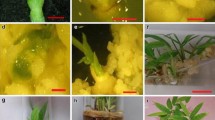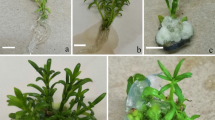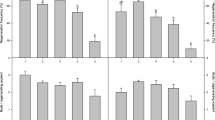Abstract
Phylloclade explants of Schlumbergera and Rhipsalidopsis were cultured in vitro to produce axillary and adventitious shoots. The explants of both species, taken from greenhouse-grown plants, produced only axillary shoots. There was a pronounced improvement in adventitious shoot formation in phylloclade explants of cultivar CB4 of Rhipsalidopsis by increasing numbers of subcultures of axillary shoots used as donor plants. The axillary shoots generated from the explants were either subcultured to produce successive generations of axillary shoot cultures or made into phylloclade explants and tested for adventitious shoot formation at each subculture. The duration of each subculture varied from 6 to 12 weeks. After the first subculture, sporadic adventitious shoot formation began, and after the third subculture 87% explants of cultivar CB4 produced adventitious shoots at a frequency of about 12 shoots per explant. In contrast, there was no improvement in regenerative ability in explants of cultivar Thor-Olga of Schlumbergera up to third subculture. Adventitious shoots could be produced by callus culture too. Cultivar CB4 was highly regenerative, producing as many as 10 adventitious shoots per square cm of callus. In vitro grown plantlets, when transferred to pots continued to show prolific growth.
Similar content being viewed by others
References
Batista D, Sousa MJ & Pais MS (1996) Plant regeneration from stem and petiole-derived callus of humulus lupulus (hop) clone Braganca and var. Brewers Gold. In Vitro Cell Dev. Biol. Plant 32: 37-41
Boyle TH & Marcotrigiano M (1997) Influence of benzyladenine and gibberellic acid on organogenesis in ‘Crimson Giant’ Easter cactus. Plant Growth Reg. 22: 131-136
Bramwell D (1990) The role of in vitro cultivation in the conservation of endangered species. In: Hernandez Bermejo JE, Clemntne M & Heywood V (eds) Proceedings of the International Congress of Conservation Techniques in Botanic Gardens (pp. 3-15). Koeltz Scientific Books
Clayton PW, Hubstenberger JF & Phillips GC (1990) Micropropagation of members of the Cactaceae subtribe Cactinae. J. Am. Soc. Hort. Sci. 115: 337-343
Evans DA (1989) Somaclonal variation - genetic basis and breeding application. Trends Genet. 5: 46-50
Fillipini R, Caniato R, Capelleti EM, Piova A, Innocenti G & Cassina G (1994) In vitro regeneration of Haplophyllum patavinum (L.) G. Don fil., a rare and endangered plant. Bot. Garden Micropropagation News 1(7): 87-90
George EF (1996) Plant propagation by tissue culture. Part 11. In practice. 2nd edn. Exegetics Ltd., Baringstoke, UK
Gurriaran MJ, Revilla MA & Tames RS (1999) Adventitious shoot regeneration in cultures of Humulus lupinus L. (hop) cvs. Brewers Gold and Nugget. Plant Cell Rep. 18: 1007-1011
Hubstenberger JF, Clayton PW & Phillips GC (1992) Micropropagation of Cacti (Cactaceae). In: Bajaj YPS (ed) Biotechnology in Agriculture and Forestry. High-tech and Micropropagation IV Vol. 20 (pp. 49-68). Springer, Berlin, Heidelberg, New York
Jain MS & De Klerk GJ (1998) Somaclonal variation in breeding and propagation of ornamentals. Plant Tiss. Cult. Biotechnol. 4: 63-75
Johnson RT, Koenigsberg SS & Langhans RW (1976) Tissue culture propagation of Christmas and Easter cactus. HortScience 11(3): 70
Larkin PJ & Scowcroft WR (1981) Somaclonal variation - a novel source of variability from cell culture for plant improvement. Theoret. Appl. Genet. 60: 197-214
Malda G, Backhaus RA & Martin C (1999a) Alterations in growth and crassulacean acid metabolism (CAM) activity of in vitro cultured cactus. Plant Cell Tiss. Org. Cult. 58: 1-9
Malda G, Suzan H & Backhaus R (1999b) In vitro culture as a potential method for the conservation of endangered plants possessing crassulacean acid metabolism. Sci. Hort. 81: 71-87
Murashige T & Skoog F (1962) A revised medium for rapid growth and bioassays with tobacco tissue cultures. Physiol. Plant. 15: 473-497
Paek KY, Lee CH, Choi JK & Kwack (1984) Mass propagation of Nephrolepis exaltata by runner tips in vitro. J. Korean Soc. Hort. Sci. 25: 313-312
Perez JC, Flores R & Ortiz G (1999) Reproduction in vitro del ‘Cactus de Navidad’ Schlumbergera truncat (Haworth) Moran. Cactaceas y Suculentas Mexicannas Tomo XLIV Ano. 44 3: 79-83
Sriskandarajah S (1984) Induction of adventitious roots in some scion cultivars of apple (Malus pumila Mill). PhD Thesis, University of Sydney, Sydney
Sriskandarajah S, Mullins MG & Nair Y (1982) Induction of adventitious rooting in vitro in difficult-to-propagate cultivars of apple. Plant Sci. Lett. 24: 1-9
Staba JE (1969) Plant tissue culture as a technique for the phytochemist. Recent Adv. Phytochem. 2: 80
Author information
Authors and Affiliations
Rights and permissions
About this article
Cite this article
Sriskandarajah, S., Serek, M. Regeneration from Phylloclade Explants and Callus Cultures of Schlumbergera and Rhipsalidopsis . Plant Cell, Tissue and Organ Culture 78, 75–81 (2004). https://doi.org/10.1023/B:TICU.0000020398.11717.88
Issue Date:
DOI: https://doi.org/10.1023/B:TICU.0000020398.11717.88




